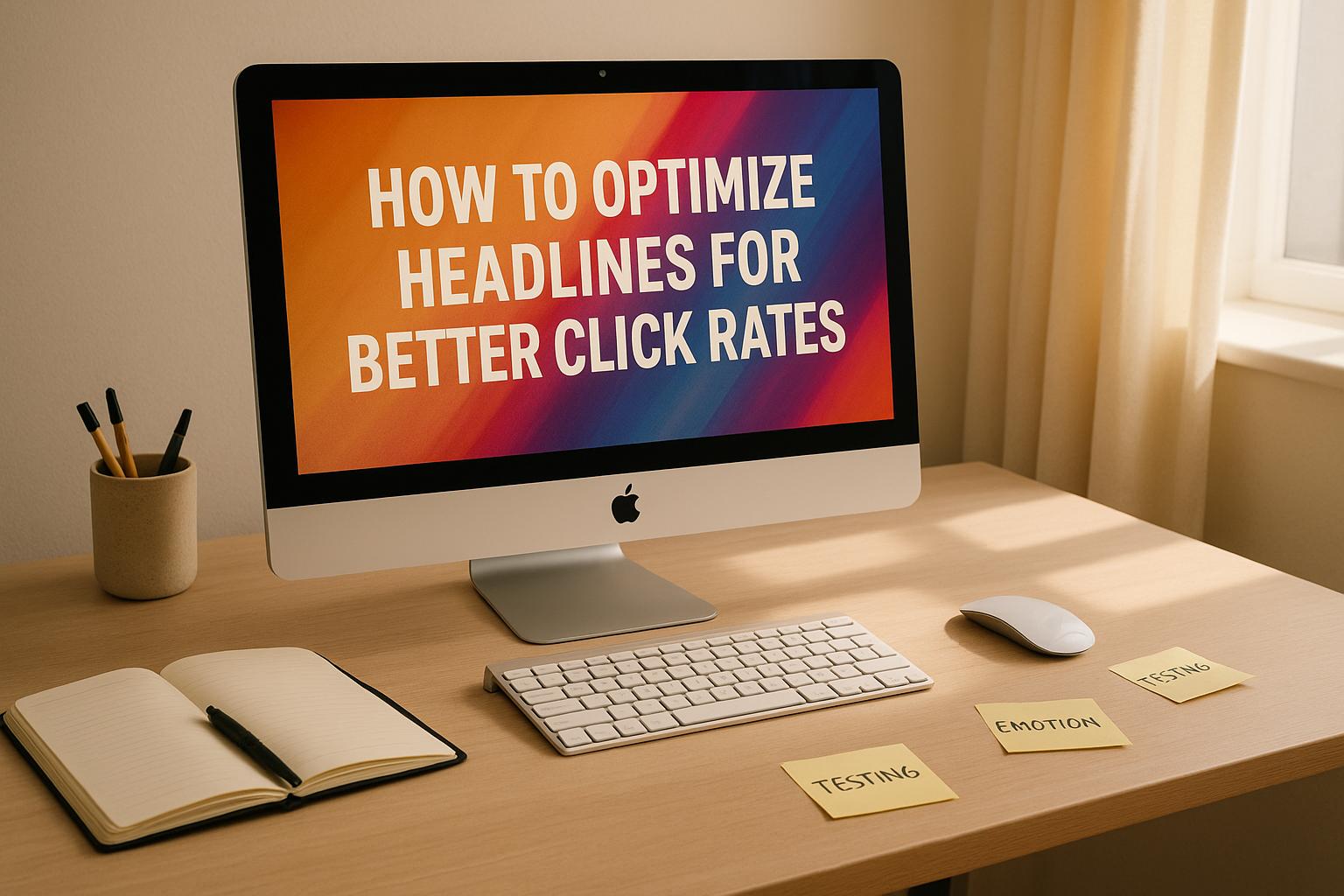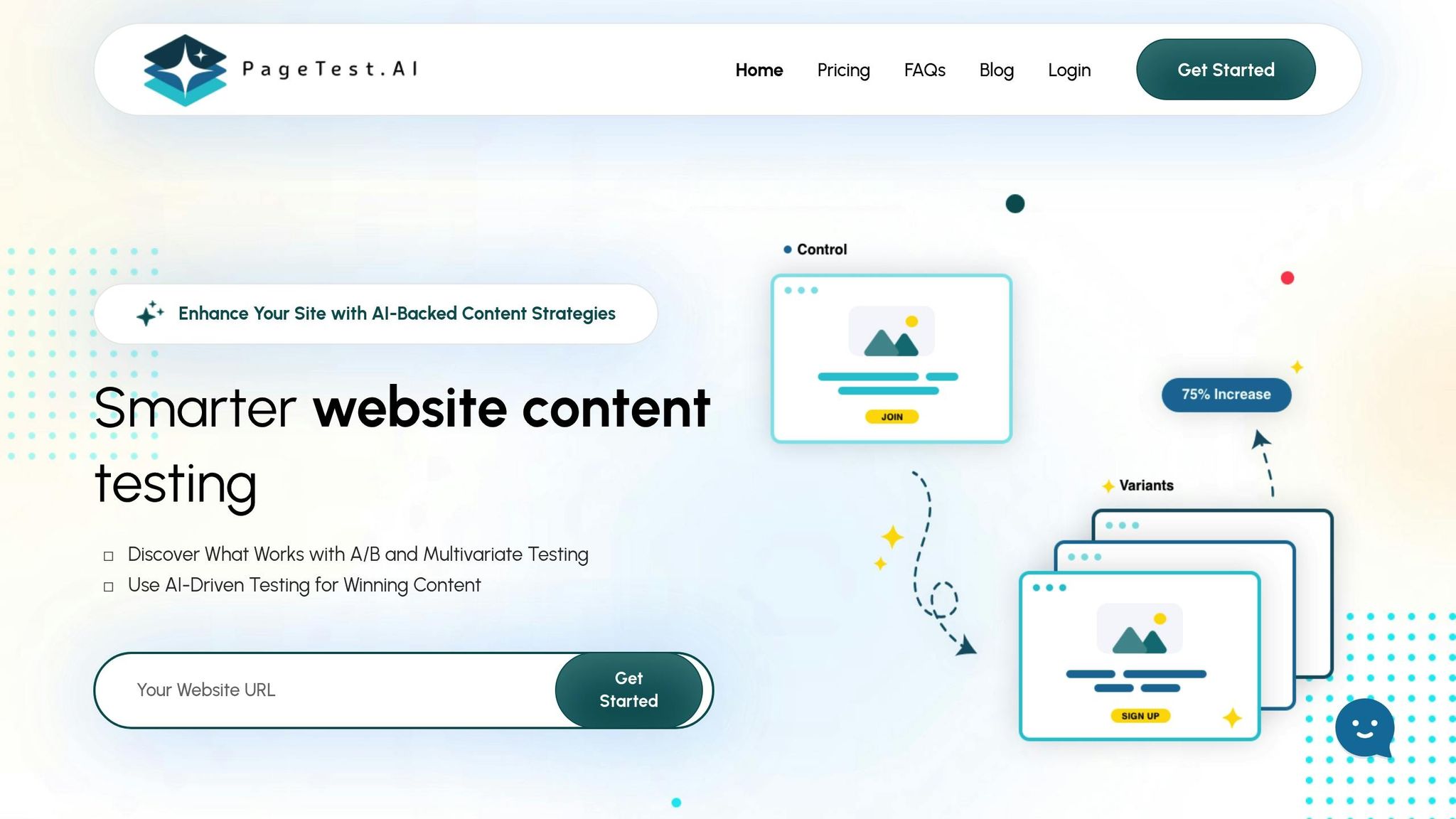

How to Optimize Headlines for Better Click Rates

How to Optimize Headlines for Better Click Rates
 22-06-2025 (Last modified: 22-06-2025)
22-06-2025 (Last modified: 22-06-2025)
Your headline is the first thing people notice – and it determines whether they click or keep scrolling. Here’s how to make it work for you:
- Use Numbers: Headlines with numbers perform 36% better.
- Tap Into Emotions: Emotional headlines can boost clicks by up to 400%.
- Be Clear and Specific: Headlines with 6–13 words get the highest click-through rates.
- Avoid Clickbait: Misleading headlines reduce trust by 43%.
- A/B Test Your Headlines: Testing can improve engagement by 25–40%.
Want to improve your headlines? Focus on emotional triggers, clarity, and smart keyword placement. And don’t forget to test and refine regularly for better results.
How to Write Click-Worthy Headlines in SECONDS With ChatGPT

Key Elements of High-Performing Headlines
To create headlines that grab attention and drive action, focus on three essential elements: emotional triggers, clarity, and smart keyword usage. The best headlines combine these factors to resonate with readers and encourage them to take the next step.
Using Emotional Triggers and Power Words
Did you know your brain reacts to emotion before logic? That’s why emotionally charged headlines are so effective – they grab attention and make people want to click. In fact, headlines that tap into emotions like curiosity, urgency, fear, success, or trust can increase click-through rates by up to 400%. Adding numbers to these emotional triggers makes them even more impactful.
Here’s a real-world example: Rich Page tested two versions of a headline on his exit popup in 2016. The original headline read, "Is Your Website Optimized for High-Sales? Grab my free conversion toolbox and start succeeding!" After tweaking it with more emotionally charged words, his signup rate jumped from 12% to 50%. Similarly, Teespring found that using phrases like "don’t worry" and explaining that users wouldn’t be charged unless a goal was met boosted conversions by 12.7%.
The trick is to choose emotional words that align with your content and the feelings you want to evoke. A few well-placed words can make a big difference without coming across as clickbait.
Here’s a quick reference for emotional words you can use:
| Positive Emotions | Negative Emotions | Surprise/Curiosity | Trust/Confidence |
|---|---|---|---|
| Thrilled, Delightful, Euphoric | Heartbroken, Devastating, Shocking | Unbelievable, Mind-blowing, Hidden | Authentic, Proven, Dependable |
| Radiant, Elated, Grateful | Furious, Anxious, Alarmed | Mysterious, Secret, Eye-opening | Trusted, Genuine, Reliable |
| Overjoyed, Blessed, Inspired | Hopeless, Defeated, Frustrated | Breathtaking, Revolutionary, Rare | Honest, Credible, Unwavering |
Once you’ve nailed the emotional appeal, make sure your headline is clear and specific.
Writing Clear and Specific Headlines
Clear headlines outperform clever ones every time. Readers are 80% more likely to engage with a title that accurately reflects the content. The key is to be specific and avoid confusing or vague wording.
Headlines with 6–9 words tend to perform the best. They’re long enough to provide detail but short enough to hold attention. Including numbers can also make your headline more structured and credible. For example, "5 Ways to…" or "3 Secrets of…" headlines often generate 73% more shares on social media.
Using active, direct language like "you" or "your" makes headlines more relatable and engaging. For instance, instead of a generic title like "Website Speed Information", try something like "How to Cut Your Website Load Time in Half." Research also shows that negative words can boost click-through rates, with each negative word increasing clicks by about 1.5%.
Once clarity is locked in, it’s time to think about keyword placement.
Keyword Placement for SEO and Relevance
Strategically placing keywords in your headline helps search engines understand your content and improves your rankings. Positioning key terms near the beginning of the headline signals relevance to both search engines and readers.
For pages to rank well, the recommended keyword density is around 2.3–2.5%. While it’s important to include keywords, make sure they flow naturally within the headline. Overloading on keywords can make your title feel clunky and robotic. Also, keep your headline under 60 characters to avoid it being cut off in search results.
Using AI Tools for Headlines
AI has reshaped how marketers approach headline optimization, making the process faster and more data-focused. Instead of relying on gut feelings or manual A/B testing, AI tools analyze vast datasets to generate multiple headline options and predict their performance before they go live. This shift allows for a more structured and efficient way to test and refine headlines.
How PageTest.AI Works for Headlines

PageTest.AI simplifies headline testing with a straightforward, no-code process. Using a Chrome extension, marketers can analyze headlines, generate optimized alternatives, and track performance metrics – all in just three steps. Here’s how it works: install the Chrome extension, navigate to your webpage, and click on the headline you want to test. PageTest.AI’s engine then evaluates your headline and produces several variations designed to perform better. The entire process is seamless, requiring no technical expertise, and it doesn’t interfere with your website’s performance.
What makes PageTest.AI stand out is its accessibility. You don’t need developers or advanced technical knowledge to run detailed headline tests. The platform integrates smoothly with popular website builders like WordPress, Wix, Shopify, and Magento, making it usable for marketers at any level of experience. The AI assesses key factors like emotional appeal, keyword placement, and clarity to craft headlines tailored to your audience. Once the test is live, PageTest.AI tracks metrics such as clicks, engagement, time on page, and user behavior to identify the best-performing headline.
Benefits of AI-Driven Headline Testing
AI-powered headline testing consistently outperforms traditional methods, delivering measurable improvements like higher click-through rates and more creative options. Unlike manual efforts, AI can generate multiple headline variations in seconds – a task that could take human writers much longer. Data-driven methods like these often lead to significant gains, with some companies reporting performance boosts of over 32% compared to relying on guesswork. By analyzing past data and user behavior, AI tools also predict how headlines will perform, enabling smarter decisions before campaigns even launch.
Comparison of AI Tools and Headline Testing Platforms
Choosing the right tool for headline optimization can make all the difference. Here’s a quick comparison of the options:
| Feature | AI Testing Platforms (PageTest.AI) | Traditional Headline Analyzers | Manual A/B Testing |
|---|---|---|---|
| Setup Time | Minutes with Chrome extension | Instant analysis | Hours to days |
| Content Generation | Generates multiple variations | Scores existing headlines only | Manual creation required |
| Performance Data | Live testing with actual users | Predictive scoring only | Live testing with manual tracking |
| Technical Requirements | No coding needed | None | Often requires developer input |
| Bias Removal | Data-driven decisions | Algorithm-based scoring | Subject to human bias |
| Continuous Optimization | Automated testing and tracking | One-time analysis | Manual monitoring required |
This table highlights how AI platforms, like PageTest.AI, go beyond traditional tools by combining predictive insights with real-world testing. Instead of relying solely on algorithmic scores, you get actual performance data from real users. This ensures your headline optimization efforts are grounded in audience behavior rather than theoretical predictions.
sbb-itb-6e49fcd
Using Headline Analyzers for Data-Driven Improvement
Headline analyzers take the guesswork out of crafting effective headlines by providing measurable insights based on proven metrics. Just like AI tools use real-time data to refine headlines, these analyzers offer a theoretical framework, turning subjective decisions into data-driven strategies.
How Headline Analyzers Work
Headline analyzers evaluate six key factors: relevance, punchiness, clarity, catchiness, context, and emotional impact. They generate an overall score that predicts how well a headline will perform with real audiences.
These tools dig into specifics like word and character count, assessing the balance between common, uncommon, powerful, and emotional words. They also evaluate headline type, readability, sentiment, clarity, and skimmability, providing a thorough analysis. On top of that, they deliver SEO scores and keyword suggestions to enhance your search engine ranking potential.
Some advanced analyzers, powered by machine learning and natural language processing, go even further, offering personalized recommendations based on your specific needs.
For example, aligning your headlines with Emotional Marketing Value (EMV) standards can boost performance. Headlines with 6–9 words, for instance, tend to achieve better click-through rates.
In August 2024, Sharethrough upgraded its Headline Analyzer with AI capabilities, enabling users to optimize headlines for specific formats like digital ads, social posts, blog articles, emails, or press releases. Their research showed that headlines scoring 84 or higher delivered an average 69% increase in attention compared to those scoring below 75.
These insights provide a robust foundation for combining analyzer feedback with real-world performance data.
Combining Analyzer Results with AI Tools
Pairing analyzer feedback with live testing tools allows you to validate theoretical insights using real audience data. This two-step process ensures your headlines are not only optimized on paper but also resonate with your target audience.
Start by running your initial headline ideas through an analyzer to evaluate emotional appeal, SEO relevance, and readability. Use the feedback to tweak specific words, experiment with different structures, or test emotional triggers. The analyzer provides instant feedback, making it easy to refine and adjust your headlines quickly.
Once you’ve fine-tuned your headlines, test them with AI tools to gather real-world performance data. This combination of theoretical optimization and practical testing ensures your headlines hit the mark. The analyzer helps you avoid common pitfalls and refine for known success factors, while live testing reveals how your audience actually responds.
Throughout this process, ensure your headlines stay true to your brand’s tone, style, and voice. Analyzers can help maintain consistency while improving performance. Incorporate A/B testing to compare headline variations and gather insights from audience interactions, enabling you to continuously improve your approach.
Best Practices for Headline Improvement
Headline optimization is a moving target. Audience preferences shift, algorithms change, and what worked a few months ago might not hit the mark today. To stay relevant and maintain strong click-through rates, you need a system for regularly testing and refining your headlines.
Test and Update Headlines Regularly
Did you know that 80% of readers never get past the headline? Even the most successful headlines can lose their edge over time, thanks to ad fatigue or evolving audience interests.
Take Crown & Paw as an example. They tested three different headline variations and saw a 3.5x boost in sales simply by finding the wording that connected best with their audience.
Here are some practical steps to improve your headline testing:
- Set clear goals. Whether you’re aiming for clicks, engagement, or conversions, define your objectives upfront.
- Create multiple headline variants. Experiment with emotional triggers, adjust the length, or compare power words to straightforward phrasing. Headlines with 10–13 words, for instance, tend to drive twice the traffic.
- Run tests long enough. Ensure your data is statistically significant before drawing conclusions. For instance, Priceonomics saw a 33% increase in pageviews after thorough headline testing.
- Track a range of metrics. While click-through rates reveal initial appeal, other indicators like time on page or social shares show how well your content resonates.
Even your best-performing headlines should be challenged regularly to push for better results. This ongoing process creates a foundation for consistent improvement.
Creating a Workflow for Headlines
Once you’re testing regularly, a structured workflow can help you streamline the process and ensure consistent results. Combining tools like headline analyzers with actual performance data can make a big difference.
Here’s how to build an effective workflow:
- Brainstorm multiple ideas. Use tools like PageTest.AI to generate headline variations you might not think of on your own. Pair these suggestions with your industry expertise to ensure they align with your brand and audience.
- Develop distinct variations. Test different strategies, such as emotional versus logical appeals or questions versus statements. Make sure each variation represents a clear approach rather than minor tweaks.
- Use A/B testing. Randomly distribute headline versions to eliminate bias and gather accurate performance data. Tools like Contentful Personalization can simplify this process by automating the distribution of headline variations.
As your tests progress, monitor key performance indicators (KPIs) to measure success. Once you’ve collected enough data, analyze the results thoroughly. Don’t just focus on which headline won – dig into why it performed better. Did emotional language outperform factual statements? Were shorter headlines more effective than longer ones? These insights will guide your future headline strategies.
When you’ve identified the winning headline, implement it across your platforms. But don’t stop there. Document what worked and use those lessons to refine future tests. This creates an ongoing cycle of improvement, helping you better understand your audience over time.
David Ogilvy, a legend in advertising, famously said: "On the average, five times as many people read the headline as read the body copy. When you have written your headline, you have spent eighty cents out of your dollar". His wisdom highlights why investing in a structured approach to headline creation can pay off in big ways.
To keep your headlines fresh and effective, schedule regular audits – monthly or quarterly – and identify underperforming content. Use these opportunities to test new ideas and approaches. This proactive strategy ensures your content stays competitive and engaging.
Conclusion and Key Takeaways
Summary of Key Strategies
Crafting effective headlines is both an art and a science, blending emotional appeal with data-backed decisions. The approaches shared here are built on proven methods that can deliver measurable improvements.
For instance, headlines that tap into emotions see a 16% higher click-through rate, while adding numbers can boost performance by 36%. Readers are drawn to clarity and specificity – headlines that promise concrete information stand out as trustworthy and engaging.
The importance of testing can’t be overstated. Companies conducting 50+ experiments per month grow their revenue three times faster than those running fewer than five. The goal isn’t perfection on the first attempt; it’s about establishing a process that evolves and improves over time.
AI tools like PageTest.AI can also speed up your headline creation by offering variations you might not think of. However, the real magic happens when these tools are combined with your expertise and insights from your audience’s behavior.
Final Thoughts on Better Click Rates
Your headlines are the front door to everything you’ve worked so hard to create. No matter how valuable your content or how polished your landing page, none of it matters if your audience doesn’t click. This is why headline testing and refinement are essential.
Businesses that embrace consistent testing see tangible results – 74% of companies with structured conversion optimization programs report increased sales. Clear, specific headlines that incorporate keywords and emotional triggers are the foundation of this success.
Start simple: pick one underperforming headline and create three variations using these strategies. Test them, analyze the results, and use what you learn to guide your next steps. Over time, these small, steady improvements can lead to significant growth.
The tools and insights are already at your fingertips. Now, it’s up to you to take action and start driving better click rates across your campaigns.
FAQs
How can I use emotional triggers in headlines without making them feel like clickbait?
To make your headlines more engaging, tap into emotions by sparking curiosity, creating a sense of urgency, or inspiring hope. Choose language that feels relatable and actionable, making it easy for your audience to connect with the message. However, always ensure the headline reflects the content accurately to maintain trust.
Steer clear of exaggerated claims or sensationalism, as these can damage your credibility. Instead, focus on being clear and honest, aligning the emotional tone of the headline with the actual value your content delivers. This strategy not only grabs attention but also fosters a strong, trustworthy connection with your readers.
What are the advantages of using AI tools like PageTest.AI for optimizing headlines over traditional methods?
AI tools such as PageTest.AI offer a quicker and more intelligent way to fine-tune headlines compared to old-school methods. Using data-driven insights, these tools help you create headlines that connect with your audience and encourage more engagement.
Instead of relying on manual processes, AI tools evaluate factors like emotional appeal, keyword positioning, and audience preferences instantly. This approach not only saves valuable time but also ensures your headlines are designed to grab attention and improve click-through rates and conversions with ease.
How often should I review and update my headlines to keep them engaging?
To keep your headlines impactful and relevant to your audience, make it a habit to review and update them regularly. A smart approach is to test them every few weeks or whenever there’s a major shift in your content strategy, audience preferences, or marketing objectives.
Regular testing lets you pinpoint what grabs attention and ensures your content stays engaging, boosting both click-through rates and overall interaction.
Related posts
say hello to easy Content Testing
try PageTest.AI tool for free
Start making the most of your websites traffic and optimize your content and CTAs.
Related Posts

 10-11-2025
10-11-2025
 Ian Naylor
Ian Naylor
How Multivariate Testing Fails Without Proper Planning
Effective multivariate testing requires clear goals, focused variables, and adequate data. Poor planning can lead to wasted resources and unreliable results.

 08-11-2025
08-11-2025
 Ian Naylor
Ian Naylor
AI in Behavioral Segmentation: 3 Success Stories
Explore how AI-driven behavioral segmentation is reshaping customer engagement, with success stories from various industries showcasing measurable results.

 06-11-2025
06-11-2025
 Ian Naylor
Ian Naylor
How Predictive Segmentation Improves Conversions
Learn how predictive segmentation can significantly enhance conversion rates and optimize marketing strategies through data-driven insights.
